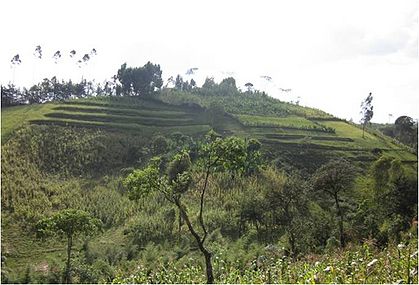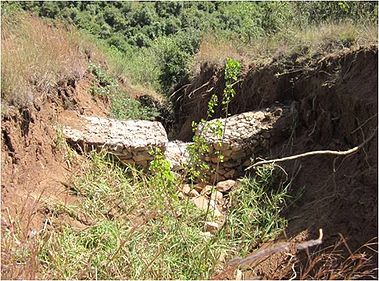The identification of appropriate mitigation and intervention techniques on the basis of the Environment Assessment is crucial for the implementation of a successful Watershed Action Plan in order to achieve a sustainable use of the catchment area and thus the MHP project. Biophysical as well as political mitigation and intervention techniques are listed in the table below:
| BIOPHYSICAL MEASURES
|
|
| Gully control
|
- Stone Checkdams
- Brushwood Checkdams
- Gully Resheping, Filling and Revegetation
- Sediment Storage and Overflow Earth Dams (SS Dams) for Productive Gulley Control
- Sediment Storage and Overflow Soil Bunds (SS Bunds)
|
Agro-forestry, Forage Development and Forestry
|
- Area Closure
- Microbasins (MBs)
- Eyebrow Basins (EBs)
- Herring bones (HBs)
- Micro-trenches (MTRs)
- Trenches
- Improved Pits (IP)
- Multistorey Gardening
- Seed Collection
|
Soil Fertility Management and Biological Soil Conservation
|
- Compost Making
- Fertilization and Manuring
- Live Checkdams
- Mulching and Crop Residues Management
- Grass Strips along the Contours
- Stabilization of physical Structures and Farm Boundaries
- Vegetative Fencing
- Ley Cropping
- Integration of Food/Feed Legumes into Cereal Cropping Systems
- Intercropping
- Crop Rotation
- Strip Cropping
|
Flood Control and Improved Drainage
|
- Waterways (Vegetative and Stone Paved)
- Cut-off Drains
- Graded Soil Bund
- Graded Fanya Juu
- Improved Surface Drainage for Increasing Productivity of Vertisols and Soils with Vertic Properties
|
Physical Soil and Water Conservation
|
- Level Soil Bunds
- Stone Bunds
- Stone Faced Soil Bunds
- Level Fanya Juu
- Bench Terracing
- Conservation Tillage using Maresha and Broad Bed and Farrows Maker (BBM)
- Hillside Terraces
- Hillside Terrace with Trenches
|
Water harvesting
|
- Hand-dug Wells
- Low cost Water Lifting
- Low Cost Micro-ponds
- Underground Cisterns
- Percolation pit
- Percolation Pon
- Farm Pond Construction
- Spring Development
- Family Drip Irrigation System
- Roof Water Harvesting System
- Farm Dam Construction
- River-bed or Permeable Rack Dams
- Small Stone Bunds with Run-on and Run-off Areas
- Narrow Stone Lines Along the Contour
- Stone Faced/Soil or Stone Bunds with Run-off/ Run-on Areas
- Conservation Bench Terraces (s) (CBT(s))
- Tie Ridge (s)
- The Zai and Planting Pit System
- Large Half Moons
- Diversion Weir Design and Construction
|
| POLITICAL MEASURES
|
|
Education and training
|
|
Income generating measures
|
|
Participatory approach
|
|
Box 1 shows three examples of how (rather simple) interventions can improve the environmental condition of the catchment. A more detailed list of mitigation and intervention techniques and the respective application can be found in DESTA, L. ET AL. (2005): Part 1: Community Based Participatory Watershed Development. Addis Ababa: Ministry of Agriculture and Rural Development, pages 69 – 165 and DESTA, L. ET AL. (2005): Part 2: Community Based Participatory Watershed Development: Annex. Addis Ababa: Ministry of Agriculture and Rural Development, pages 43 - 48.
Box 1:
Fenced vs. unfenced springs/wetlands
Springs and wetlands not only guarantee the discharge in dry season, also they have a great retention capacity during and after rains. Springs are sensitive areas that react to disturbances easily. Protection of springs and wetlands is thus crucial for the sustainable use of the MHP projects. Protection measurements might include fencing (to protect the areas from cattle step and thus soil compaction), protection of natural vegetation around the springs, protection of a natural humus layer (in order to sustain sufficient infiltration and thus groundwater recharge). Furthermore fencing can help to improve the water quality, since pollution due to agricultural and pastoral use can be prevented[1].
Buffered vs. unbuffered riverbanks/wetlands
A buffer typically consists of a band of vegetation along a wetland or water body, preferably natural habitat, but including previously altered, stable native or introduced species. A buffer can perform a variety of functions, which can improve the environmental condition of a watershed, such as sediment removal and erosion control, runoff reduction through infiltration, reduction of human impacts by limiting easy access as well as barrier to invasion of exotic species[2]. Thus buffers can benefit the sustainable use of the MHP and should hence be established and/or protected.
Eucalyptus vs. indigenous plants
Eucalyptus easily adapts to any soil and water condition, it is characterized by fast growth, high survival, long roots and hard leafs. Those features make it economically very beneficial. When it comes to watershed management, its negatives sides should be considered though: it does not only take a lot of nutrients and water and is hence a high competition to companion plants and decreases biodiversity, also soil erosion can occur which can negatively affect the MHP’s performance. FAO thus recommends that large scale monocultures of eucalypt plantations be excluded from watersheds, aforestation projects should avoid monocultures and the use of eucalypts. The only way to include eucalyptus is to adopt it in agroforestry systems, but the proportion of each species should be planned out carefully[3].
|
References
- ↑ HELVETAS (2005): Helvetas Wasser Fact Sheet: Quellen und Quellschutz.
- ↑ GALE, J.A. (unknown): Watershedss Wetland Management. http://www.water.ncsu.edu/watershedss/info/wetlands/manage.html#prot
- ↑ SUNGSUMARN, K. (1993): Why Eucalyptus is Not Adopted for Agroforestry. In: Kashio, M. et al. (Hrsg.)(1996): Reports Submitted to the Regional Expert Consultation on Eucalyptus - Volume II. Bangkok: FAO Regional Office for Asia and the Pacific.
Per






















